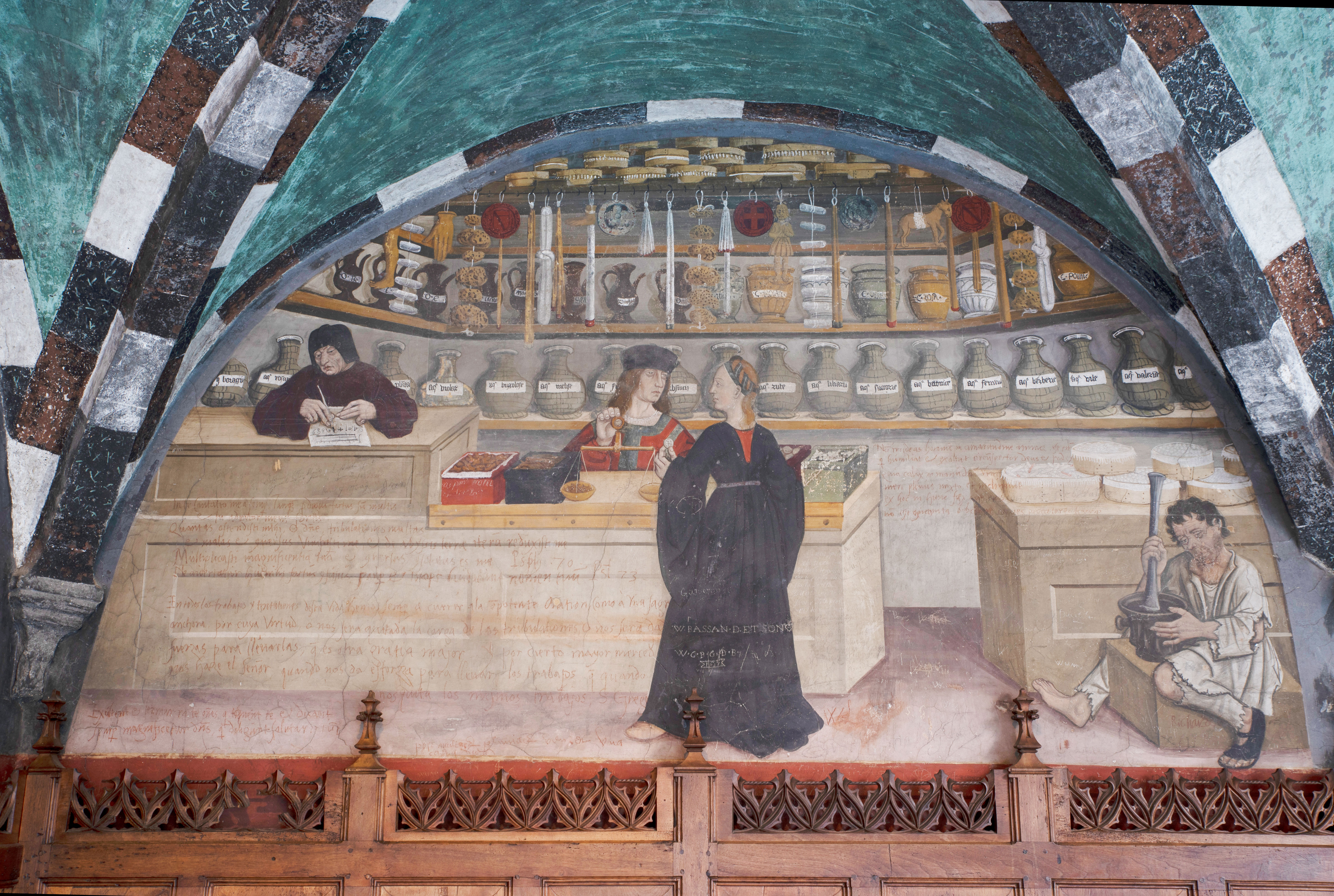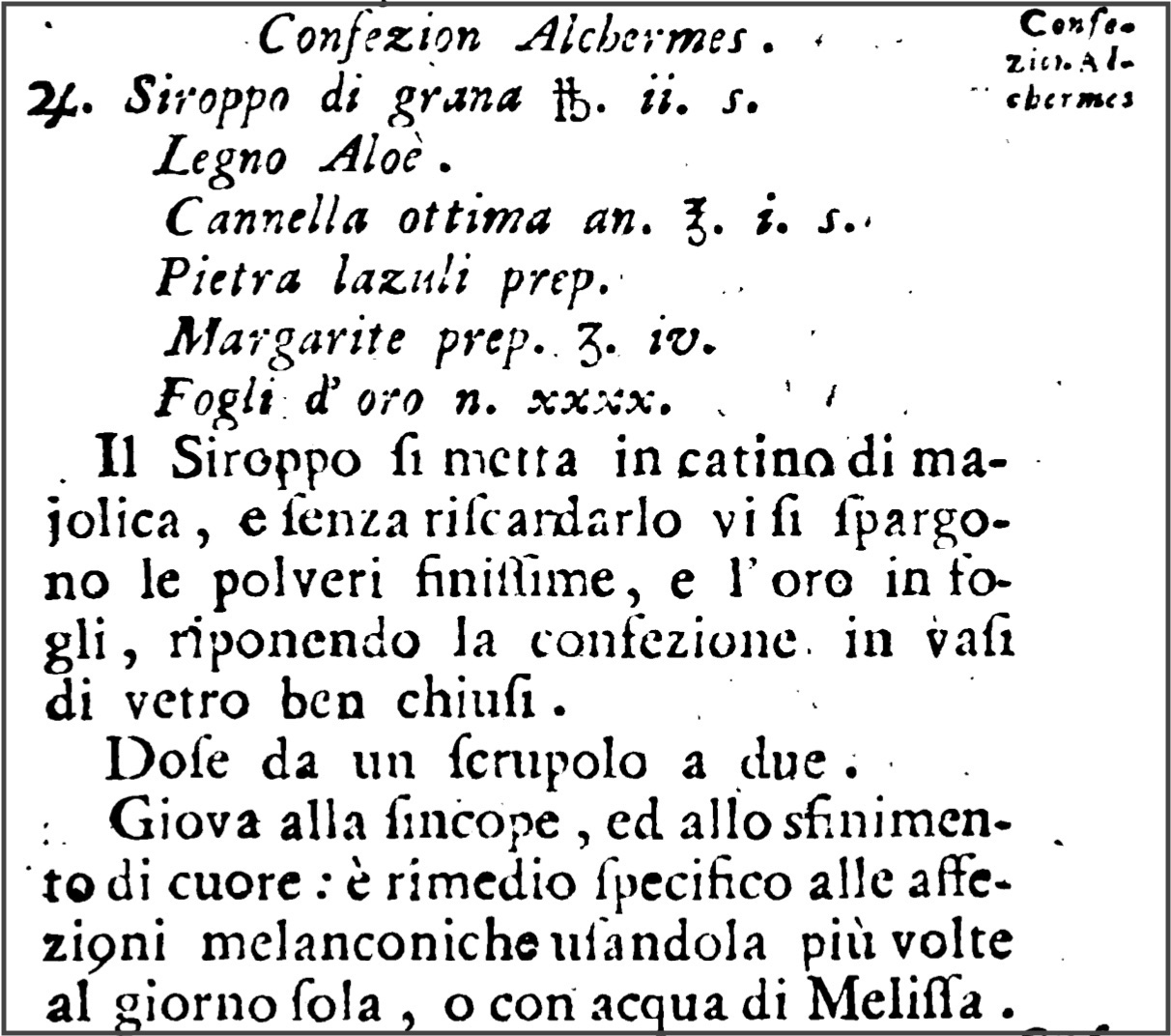15th_century
Introduction to 15th Century Apothecary Shops
One of the oldest and most detailed depictions of the interior of an apothecary shop is a fresco at the castle of Issogne, in Val d’Aosta (North-West Italy). Frescoed in the Renaissance period, it actually intends to recreate a medieval setting.

This was an apothecary shop that served the few inhabitants of a mountainous area in North-West Italy, selling not only medicines but also a range of products for everyday life.
While Venetian apothecary shops specialised exclusively in medicines, in the fresco at Challant Castle, not only medicinal products appear, but also confectionery and food spices, wax products (for lighting and other uses), votive offerings depicting body parts, sponges, toys etc. In fact, hanging from the fourth shelf on hooks are: white and coloured wax torches, wax candles, wicks for torches, sponges and cylinders of melted sulphur tied with string, large red and green blocks of wax for seals, worked with Savoy coats of arms; a small saddled horse (ex voto for St. Egidio), a human figure and a wax leg (ex voto for the healing of a person and a limb).
A woman is shopping with the shop assistant, while a boy, in the right-hand corner of the scene, is pounding substances in a mortar - an operation usually carried out in the adjacent workshop or in the backroom. Medicinal waters and oils are displayed on the shelves.
Bottom shelf
The 18 faience vessels on the bottom-most shelf contain distilled waters.

- Aqua boraginis: Water of Borago officinalis L.
- Aqua rosarum: Rose Water - Rosa Gallica L.
- Aqua plantaginis: Plantain Water - Plantago L.
- Aqua violarum: Violet Water - Viola L.

- Aqua buglosse: Bugloss Water - Anchusa officinalis L.
- Aqua melis[s]e: Lemon balm Water - Melissa officinalis L.
- Aqua f[?]
- Aqua absincii: Absinth Wormwood Water - Artemisia absinthium L
- Aqua rute: Rue Water > Ruta graveolens L.
- Aqua liliarum [sic per liliorum]: Lily water - Lilium Tourn. ex L.

- Aqua succorie [sic]
- Aqua betonice: Betony Water > - Stachys officinalis L.
- Aqua feniculi: Fennel Water - Foeniculum Mill.
- Aqua berberie: Barberry Water - Berberis L.
[cfr. Berberine and barberry (Berberis vulgaris): A clinical review - Aqua vite: Vite L.
- Aqua valeriane: Valerian Water - Valeriana officinalis L.
Second Shelf

The second shelf holds eight amphorae of oils on the left side. The first is labelled Oleum rosatum.

On the right side of the second shelf are jars with jams and preserves.
 Alkermes For the recipe for alkermes syrup “a base di sciroppo di cocciniglia” (based on cochineal syrup), see Capello, Lessico farmaceutico-chimico, p. 52, Confezion Alchermes
Alkermes For the recipe for alkermes syrup “a base di sciroppo di cocciniglia” (based on cochineal syrup), see Capello, Lessico farmaceutico-chimico, p. 52, Confezion Alchermes- Conserva rosacea
- Conserva olivarum
- Conserva rosarum
- Conserva pomorum
Hanging from the fourth shelf on hooks are: white and coloured wax torches, wax candles, wicks for torches, sponges and cylinders of melted sulphur tied with string, large red and green blocks of wax for seals, worked with Savoy coats of arms; a small saddled horse (ex voto for St. Egidio), a human figure and a wax leg (ex voto for the healing of a person and a limb).
Fourth Shelf

The top shelf holds round boxes and wooden crates. These are lined on the inside with paper and contain herbs, roots, spices, seeds, pills, troches, sugar, resin, etc.